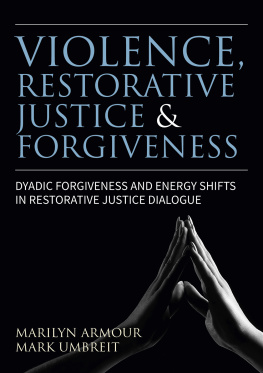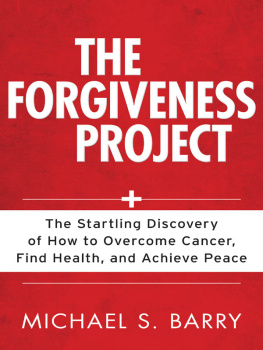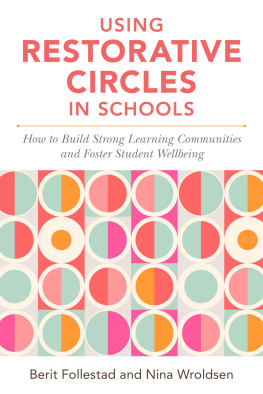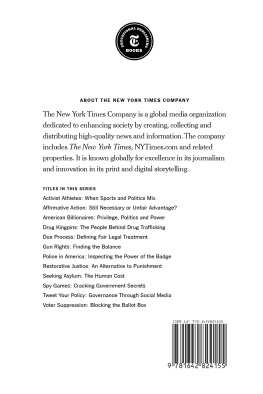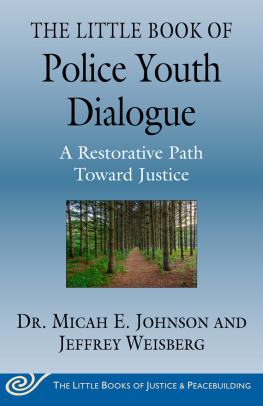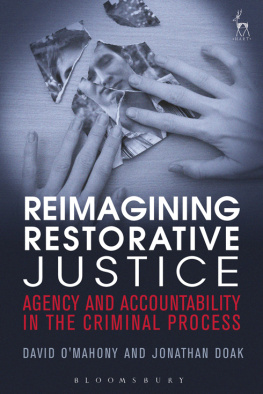
VIOLENCE,
RESTORATIVE JUSTICE
AND FORGIVENESS
Dyadic Forgiveness and Energy Shifts in Restorative Justice Dialogue
M ARILYN A RMOUR A ND M ARK S. U MBREIT

Jessica Kingsley Publishers
London and Philadelphia
CONTENTS
FIGURES
PREFACE
Restorative justice has emerged internationally as a viable response to the harm caused by crime. Its acceptance and promotion are underscored by the fact that the United Nations (2000) has adopted a set of principles that encourage use of restorative justice programming by member states. In addition, the Council of Europe (2001) supports its use in criminal matters while the American Bar Association (1994) promotes the use of victim offender mediation (VOM), which is the oldest, most widely used and empirically grounded form of restorative justice, in courts throughout the United States.
Restorative justice begins with the crime or wrongdoing and the far-reaching consequences for the victim, offender, and others. For the victim, there is a common response referred to as victim unforgiveness (Worthington and Wade, 1999), which occurs as the victim ruminates about the transgression and its consequences. Specifically, resentment, bitterness, hostility, hatred, anger, etc. can coalesce over time into a cold complex of emotions called unforgiveness. Unforgiveness can be described as the emotional consequence of the perceived distance between desired justice and the victims sense of injustice. Restorative justice endeavors to decrease that distance, and the lack of resolution associated with unforgiveness, by opportunities for face-to-face meetings between victim and offender. Indeed, forgiveness and involvement in a restorative justice intervention have been shown, under experimental conditions, to be statistically equivalent in reducing levels of unforgiving motivations, anger, and arousal, and in increasing levels of empathy, forgiveness, positive emotions, and control (Witvliet et al ., 2008).
Although forgiveness and reconciliation are important philosophical objectives for many within the restorative justice movement, little attention has been paid, until now, to defining or examining how these terms function in various contexts. The purpose of this project is to explicate dyadic forgiveness in victim offender dialogue (VOD), also called victim offender mediated dialogue (VOMD), by studying behaviorally implicit forgiveness and the process of victim and offender shifts in energy from the time of the crime through the restorative dialogue.
The project has four sections:
A review of the literature on forgiveness in restorative justice with particular attention to the construct of dyadic forgiveness and the interpersonal dynamics of influence : This section highlights the difficulties with forgiveness in restorative justice, the lack of information on implicit forgiveness, and the importance of energy shifts in behavioral change. A model of the change process in VOD for victim and offender dyads of seriously violent crime is proposed as a starting point for the project. This model is derived from a systematic review and retrospective analysis of restorative justice cases and archival materials on VOD.
A qualitative study of 20 victims who experienced a positive emotional energy shift as a result of their participation in a VOD with their offender : Data were collected largely from victim survivors (family members) of murder cases. These cases serve as exemplars of dyadic forgiveness. Each of the victims narratives is summarized in their words and then analyzed using the model of the change process proposed in Section 1. Although every case is unique in the circumstances of the crime and context for the VOD, the analysis highlights the dynamics across all cases that allow for openness in dyadic engagement, transfer of the victims pain to the offender, positive energy shifts in both victim and offender, and transformation of the victims pain. Particular attention is given to the processes leading up to the dyadic dialogue as well as what occurs for victims in the aftermath of the meeting.
A cross-case analysis and discussion of the findings about dyadic forgiveness from the 20 victim case narratives : The model proposed in is expanded and reworked based on the findings. Shifts from negatively to positively charged energy are noted both in terms of a series of graduated shifts that build on each other and core shifts that significantly transform the direction and quality of the energy. Dimensions of verbally explicit and behaviorally implicit forgiveness in dyadic forgiveness are identified. In addition to information on the studys methodology, this section is subdivided into findings on the a) crime and its impact, b) victim motivation and VOD preparation, c) the dyadic dialogue, d) resolution and post-dialogue outcomes, and e) dyadic forgiveness. The section concludes with a formulation about dyadic forgiveness and its processes and key attributes based on the results from the literature review, the VOMD study, and the study of 20 victims.
There is a significant literature on individual, unilateral, and intrapsychic forgiveness. This literature centers on the forgivers motivations, tendencies or characteristic traits to forgive over time and across situations. The literature of dyadic forgiveness is exceedingly limited. Yet many victims of seriously violent crime report dramatic personal change in attitude toward the offender and in healing after meeting with an offender. Part of the dearth in information is because forgiveness in restorative justice is not a part of the agenda for victim change. Restorative justice facilitators do not ask victim participants to forgive or to report experiences of forgiveness. Indeed, the maxim in the restorative justice field is that forgiveness is less apt to occur the more it is prescribed. Because it is deliberately made irrelevant, restorative justice has placed the examination of forgiveness outside its own field of inquiry.
Although this position is understandable, the concept of forgiveness in restorative justice cannot be ignored. It is a potent and promising outcome of the interpersonal nature of the dyadic dialogue. Our taboos around it, as well as ignoring or downplaying its existence, deprive us of much needed knowledge in a world beset with few avenues for repair and sustained healing. The restorative justice field offers an unusual opportunity for studying dyadic forgiveness because of its focus on wrongdoing, accountability, humanization, and amends making. This project seeks to open the door on the concept and importance of dyadic forgiveness. Instead of a focus on public acknowledgement of forgiveness or forgiveness as a goal, the project examines shifts in victims from negatively to positively charged energy as a result of dyadic engagement and as an indicator of dyadic forgiveness.
REFERENCES
American Bar Association (1994, Approved August 1994). Policy on legislative and national issues. In American Bar Association (Ed.) Policies and procedures handbook (p.730). Chicago, ILL.
Council of Europe: Commission of the European Communities. (2001). Report from the Commission on the basis of Article 18 of the Council Framework Decision of 15 March 2001 on the standing of victims in criminal proceedings . COM (2004) 54 final/2, 16.02.04. Retrieved January 7, 2010 from http://europa.eu/bulletin/en/200012/p104015.htm
Umbreit, M. (2013) Being with the energy of forgiveness: Lessons from former enemies in restorative dialogue (film). Center for Restorative Justice and Peacemaking, St. Paul, MN. Available from https://www.youtube.com/watch?v=8OUnOpbmb7g
Next page
